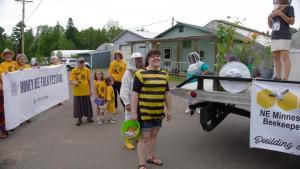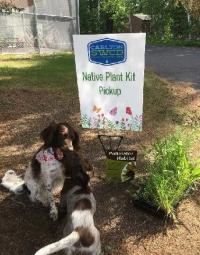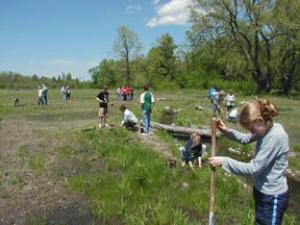What's Working for Conservation
Partnering
2025 Information
Lyon SWCD and City of Marshall HELP Grant
The partnership between the Lyon SWCD and the City of Marshall has grown tremendously throughout the process of starting a 15.1 acre prairie enhancement and 4 acre prairie establishment project on city of Marshall owned property. Project planning has been fairly simple with hiring a contractor to create a game plan, get the diverse seed mix for both sites, doing a prescribed burn, and doing the seeding.
Project installation was a bit of a challenge with it being so dry last summer. The original plan was to do a few mowing’s, spray out the Smooth Brome on the establishment site, do a fall prescribed burn, as well as a dormant seeding. Our timeline was pushed due to inadequate weather conditions and working with the contractor’s schedule. The partnership with the City of Marshall has been important for the success of the project. City staff are assisting with the establishments of the newly planted pollinator seed by mowing down weeds once they have grown to around 12-18” to allow the newly establishing prairie plants to grow.
2020 Information
Lawns to Legumes Demonstration Neighborhood Grantee
Introducing the POLLINATOR POWERHOUSE: The Carlton Soil and Water Conservation District, partnering with the Oldenburg Arts and Cultural
Community and The Xerces Society for Invertebrate Conservation, was awarded funds from the Lawns to Legumes Pilot Program Demonstration Neighborhood Grant in April 2020. The Lawns to Legumes Pilot Program focus is to establish pollinator habitat projects on residential and tribal landscapes across Minnesota to support the Rusty Patched Bumblebee and other pollinators. Creating pathways and corridors throughout Carlton County and the Fond du Lac Reservation, and extending into neighboring regions via our outreach efforts, will increase pollinators' access to quality forage, nesting sites, and corridors for movement. Our goal consists of 3 components: 30 pollinator plantings; pollinator conservation outreach to over 200 community members in the region; and technical support throughout the duration of the projects.
Our goal is having residents host these demonstration sites within Carlton County and the Fond du Lac Reservation. Residents and other partners will join in this corridor throughout the Arrowhead Region, truly creating the first of its kind Pollinator Corridor. These sites will help spread the word about the importance of pollinators as well as educate neighbors, families, friends, communities, and city officials.
We created ads and articles that were published and shared through our own organizations and partner local newspapers, social media, websites, and mailings. We partnered with MN Native Landscapes to offer 7 different, pre-ordered native plant kits, reaching a record of theirs by selling 196 kits! The sale was held in mid-June with curbside pickup and social distancing. What folks were most excited about was that the first 50 households to pick up kits received a donated pollinator sign from Xerces Society! The best part about this is that it is showed landowners were excited about this new opportunity for pollinator conservation. Plus, these were voluntary plantings; not using any cost share or funding. (Alyssa Bloss, Conservation Specialist II, Carlton SWCD)
2018 Information
Potential Partners: Groups that are important partners include birding clubs, environmental groups and chapters, and sportsmen's and conservation organizations such as Wildlife Heritage Association, Ducks Unlimited, Pheasants Forever, MN Waterfowl Association, and MN Pheasants Inc. (DNR Roadsides for Wildlife Program).
Landowner Match: Multiple cost share opportunities throughout the county drive a lot of our projects. We always have a minimum project input of 25% from the homeowners. Hoping they will be more vested in the project and want to maintain it (Ramsey SWCD).
Volunteer Involvement: If you use volunteers on a project, this can reduce the overall cost of the project, and if they are local, can give them a sense of ownership in the project, so it is a good thing. Here are some tips I have learned when working with volunteers. Beforehand, give them a clear idea of what they are expected to do, so they can dress appropriately--no open-toed shoes, yes leather gloves, etc. This goes a long way in how effective and happy they are on the project. Before they start the work, show them the project site and acquaint them with the goals and objectives of the project. While they are working, give them plenty of attention, monitoring their activities fairly closely--that way you catch, right away, things that they may be doing incorrectly so that you don't have to re-do anything later. After the work is over, get feedback from them so that you and they can both learn for future projects (Joe Walton, Refugia LLC).
Partnering on Project Review: A project was recently proposed to clean out sediment in a DNR protected watercourse that had already been straightened many years ago. The proposed project needed approvals from DNR, WCA, Swampbuster, and the Corps of Engineers. Some agencies were quick to want to approve the project because the words "maintenance" and "ditch" were part of the request, but a couple of those agencies were not so quick to approve the project. To make a long story short, several of those agencies got together and met in the field to determine if the proposal was truly a maintenance project vs. a drainage improvement project. It sure appeared on the profiles that were provided to be more of an improvement project. After several hours of field work by people from 5 different agencies it was confirmed that the proposed project to clean out the watercourse indeed went well beyond just removing sediment that had been deposited over the years. The proposal would have lowered portions of the watercourse causing significant drainage to wetlands along this watercourse and very likely would have increased sedimentation into a large wetland on a WMA by excavating into natural soil profiles that had potential for high velocity flows from the steeper grade. In the end, I think this effort by many people is a great example of when resources can be protected ahead of time through cooperation amongst different agencies and the diligent work by staff in the regulatory field. It is not usually rewarding to say “NO” to applicants but for this project I feel the regulators involved felt OK or even good about saying “NO” because the reward of protecting the natural resources was very real (Kane Radel, Minnesota Board of Water and Soil Resources).
Easement Partnerships: Since 2006, BWSR and the local Soil and Water Conservation Districts in Morrison, Crow Wing, and Cass Counties partnered with the Department of Defense and the National Guard Bureau to convey easements within a three mile corridor around Camp Ripley in central Minnesota. Camp Ripley was the second military base in the country to receive funding for the initiative to secure land surrounding their training facility to ensure the continued ability to train soldiers year around. Already partnered with the DNR and The Nature Conservancy since 2004, the program struggled with getting the program dollars spent since they dealt with primarily fee title acquisitions and most of the landowners were interested in easements instead. It was a perfect fit for BWSR, who already held thousands of easements statewide under the Re-Invest in Minnesota program and CREP. Since mid 2006 BWSR has received $10,892,500 in federal funding. In 2010, the state matched the effort with a Lessard/Sams grant to coordinate ACUB with another initiative to protect the Nokassippi Wildlife Management Area. The Lessard/Sams grant in the amount of $618,000 was paired with a matching amount of federal ACUB dollars and in less than eight months secured approximately 1,100 acres in permanent easements. Not only reducing development in the ACUB zone and surrounding the WMA, the easements protect valuable forestry resources, for under $1,200 per acre. The remainder of the Lessard/Sams grant went to the DNR for fee title acquisitions in the WMA area. The SWCD’s and Camp Ripley have well over 300 landowners that have signed their Landowner Interest/Ranking forms. The Camp Ripley ACUB program has been nationally recognized as the most successful in the country and has fostered partnerships that are being held up as the ideal nationwide (Helen McLennan, Morrison SWCD).



